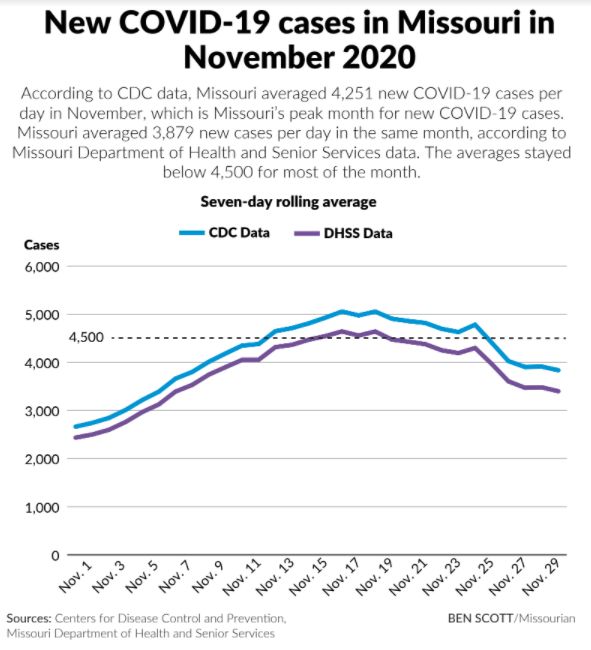Democrats exaggerated Missouri’s November COVID-19 caseload
Democrats in Missouri’s House of Representatives took aim at Gov. Mike Parson and his handling of the coronavirus pandemic in a March 22 tweet.
After Parson touted the fact that he had no statewide mandates in response to the coronavirus pandemic, the Missouri House Democratic Caucus responded on March 22 by saying, “Oddly, he chose not to gloat when an average of nearly 5,000 Missourians were contracting COVID every day in November. And we didn’t have statewide mandates then either.”
Parson’s strategy throughout the pandemic was to enact as few statewide mandates as possible. This frustrated Democrats who believe this strategy allowed the coronavirus to spread out of control, specifically in the worst months of the pandemic.
November was Missouri’s peak in cases throughout pandemic, but was the average really close to 5,000 every day in November? We took a look.
Data from the DHSS
A representative of the Democratic Caucus told us they used data from the Missouri Department of Health and Senior Services. He also said that they used data from Nov. 7 to Dec. 5, but since the text of the tweet said “in November,” we looked at Nov. 1 to 30.
We looked at the data in a few ways. We began with data from Nov. 1 to 30, because that’s the period the tweet actually described.
First, we looked at the seven-day rolling average of new daily cases. In other words, we took the number of new cases for each day, added that to the sum of new cases for the preceding six days and divided that number by seven. Looking at the rolling average helps smooth out fluctuations due to uneven reporting from day to day, such as weekends and holidays.
In November, there were four days when that rolling average was above 4,500. For the first 10 days, this number was in the 2,000s and 3,000s. It reached 4,500 about halfway through the month, on Nov. 16. It peaked Nov. 19 at 4,753.
We also took the daily average for the entire month — by adding up all the new cases from each day and dividing that by 30. That came out to 3,879 new cases a day.
There were two days where the number of new cases topped 5,000: Nov. 13 with 5,870 new cases and Nov. 25 with 5,108.
Data from the CDC
There are multiple agencies tracking this data, and sometimes the numbers can vary a little bit due to minor differences in reporting methods. So, we also took a look at data from the U.S. Centers For Disease Control and Prevention. There, we found higher numbers, but still not quite what Democrats were claiming.
For the seven-day rolling average, the CDC data shows 13 days in November where it surpassed 4,500. For the first week, the number sat in the 2,000s and 3,000s. It surpassed 4,500 on Nov. 13, when it was 4,647. Two days had averages above 5,000: Nov. 17 at 5,055 and Nov. 19 at 5,054.
The daily average for the month was 4,251 new cases.
What about Nov. 7 to Dec. 5?
Although the text of the tweet said November, we figured we’d also check data from Nov. 7 to Dec. 5, which is what the Democratic caucus said it used. Here, we used DHSS data again, and the results were similar.
In this 30-day period, there were also four days where the seven-day rolling average was above 4,500. None of the five days in December had a seven-day rolling average above 3,800. The six days in November that this time period excludes all have seven-day rolling averages below 3,200.
The daily average of this 30-day period is 4,007 new cases a day.
Our ruling
The Missouri House Democratic Caucus said that “an average of nearly 5,000 Missourians were contracting COVID every day in November.”
This is an exaggeration. November was Missouri’s peak in COVID-19 cases, and daily new-case numbers were in the thousands, but to say that the average was near 5,000 every day is inaccurate.
We rate this statement Mostly False.
Read More: Democrats exaggerated Missouri’s November COVID-19 caseload


